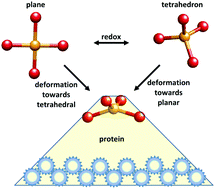Hypothesis: entatic versus ecstatic states in metalloproteins
Abstract
Over half a century ago the hypothesis was put forth that redox-active metal ions and multidentate protein ligands may combine to form a local state of entasis: an irregular symmetry intermediate between those dictated by coordination chemistry for the two redox states involved. Such an energetically poised domain would be at the basis of high activity (notably electron-transfer rates) in biological systems. Today the concept of the entatic state has become textbook material. Based on EPR spectroscopic data it is proposed here that poised, entatic states may only be of marginal existence; rather the occurrence of relatively wide distributions of coordination geometries (or: ecstatic states) afford a stochastic tuning of structure towards low-energy unimolecular transition states.



 Please wait while we load your content...
Please wait while we load your content...